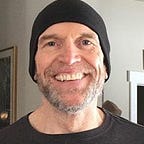A Tale of Two Countries
It’s official: the U.S. is split in half — not just on everything, as we already know, but also in economic terms: half of us are poor, half of us aren’t.
Well, not quite. Joe Biden apparently got his math wrong when he said half of Americans are poor. More accurately, according to a 2017 Federal Consumer Financial Protection Bureau report,
“Measured by the By the Official Poverty Measure (OPM), more than 95 million Americans (nearly 30 percent of the total population) are either in poverty or considered ‘low-income’ (living below twice the poverty line) … That number rises to 140 million people (43.5 percent) when using the (SPM) [Supplemental Poverty Measure].”
Fact Checker: Joe Biden’s Claim That ‘Almost Half’ Of Americans Live In Poverty, The Washington Post (June 20, 2019)
Right-leaning Ballotpedia also corrected Biden’s math, concluding that only 32% of Americans are technically poor. On the other hand, progressive Common Dreams is sticking with one-half.
Glad we got that cleared up.
Besides, what’s “poor” anyway? Are we talking poverty, poor, low income, or what? Again from The Washington Post’s Fact Checker:
“The OPM was adopted in the mid-1960s and has garnered widespread criticism because it measures pretax income and food-purchasing power, updated yearly to account for inflation. That methodology, experts say, fails to capture many people struggling financially in modern society.
“The Census Bureau responded with the SPM, which since 2011 has measured after-tax income, food costs and other necessities such as clothing, housing and utilities. The SPM accounts for geographic variations in the cost of living, includes welfare benefits such as food stamps and housing subsidies, and subtracts child-care expenses.”
Therefore, apparently “poor” is about food, housing, utilities, and child-care — subject to how much you make on the dole. But what about childcare for people not on public assistance — are you poor if you can’t afford that? Or how about healthcare, education, transportation? Internet access? Cell phone? Or what if you can’t come up with $500 to cover an unexpected expense? (Something 63% of American’s couldn’t do, according to this Forbes article.) Or what about a car, washer and dryer, TV, air conditioning…maybe even home ownership, a shot at upward mobility, or relief from the insecurities of the gig economy?
We have now landed squarely in the center of the necessity vs. luxury debate, which will endure until the seas all melt, and to which the most reliable answer seems to be, it depends on what socio-economic level you’re talking about. For the middle class and up, things like a reliable car, smart phone, high-speed wireless, home ownership, savings… plus the occasional night out… are givens. As for the poor,
“There is a moralistic presumption that poor people, especially those receiving benefits, should not be spending money on anything but the bare essentials, denying themselves even the smallest ‘luxury’ that might make their lives less miserable.”
Basic Income: A Guide For the Open-Minded, Guy Standing (2017) [1].
If “only” 32%, or maybe 43.5%, or even half of Americans are below, at, or just above the official poverty line, the USA has truly become what one writer calls “the world’s first poor rich country.” That means look left, look right, and one of you:
- Does not plan for the future in the press of making ends meet right now;
- Makes money and purchases stretch as far as possible;
- Is shadowed by the what if? of emergencies and other unplanned costs;
- Regularly opts out of social engagements for lack of funds;
- Relies on unreliable transportation to get around;
- Constantly sacrifices this I order to do and havc that;
- Does not ask for help because it’s too embarrassing and shameful.
Everyday Things Poor People Worry About That Rich People Never Do, Everyday Feminism (May 7, 2015),
If none of those apply, then either you’re a member of the top 10% economic upper class or you’re part of the middle class that hasn’t vanished yet. Otherwise, “poor” can happen even right here in our house. If I’d thought about it back in the day (but of course I didn’t), I’m sure there were three things I would have thought I’d never be: old, poor, and infirm. Now, by federal standards, I’m all three. I’m also certain I never would have thought that the best financial day I’d ever have was the day I qualified for disability income. Amazing what a social safety net can do for your outlook.
Old, poor, and infirm are three reasons why I’ve been writing about economics and jobs for the past couple years. One of the many things I’ve learned is that law and economics are inseparable — which is obvious if we ever think about it, but usually we don’t. Click here for an article about how law creates economic reality.
Next up: we’ll meet a human species you’ve probably never heard of.
[1] The results of my Google searches on necessities vs. luxuries were fascinating. I highly recommend your own. See, e.g., this article that cites a 2009 Pew Research Center poll re: what Americans considered necessities at that time. I didn’t find an exact Pew follow up, but for something close, see this 2016 research study that identified job security and the ability to save money as prerequisites for being considered middle class.
Originally published at http://theneweconomyandthefutureofwork.wordpress.com on July 4, 2019.
